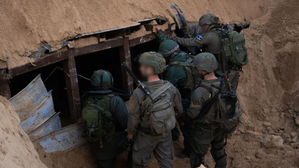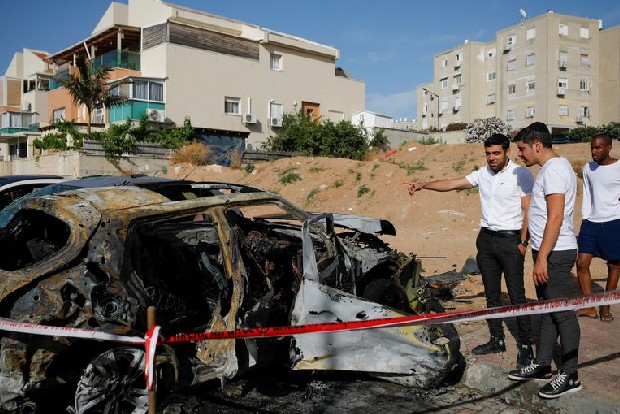Middle East Silos and saturation salvoes: Gaza rockets bedevil Israel
Israel has been heavily shelling densely populated Gaza, where officials say 219 Palestinians have been killed, many of them civilians. Israel says at least 160 guerrillas have been killed, among them rocket operators and manufacturers.
Named after slain Islamist commanders and fashioned mostly from makeshift materials in clandestine Gaza workshops, the rockets of Hamas and Islamic Jihad have long bedevilled a technologically superior Israeli military. The current cross-border fighting has seen a new tactic by the Gazan militant groups: mass-launches aimed at exploiting the statistical failure rate of Israel’s air defences and increasing the chance of causing casualties in its cities.
The rocket fire has set off a near-incessant wail of sirens in Israeli communities near the Gaza border and prompted tens of thousands of residents to seek shelter. Twelve people have been killed in Israel since the hostilities erupted on May 10.
Israel has been heavily shelling densely populated Gaza, where officials say 219 Palestinians have been killed, many of them civilians. Israel says at least 160 guerrillas have been killed, among them rocket operators and manufacturers.
According to Israeli officials, a Gaza arsenal of around 29,000 rockets or mortars before the violence began has now been halved. Hamas and Islamic Jihad have not confirmed that.
The factions’ promotional videos have shown rockets being pre-loaded into small silos for remote-launches – a means of keeping their operators protected from Israeli counter-strikes.
Counter-strikes may also be delayed or called off against manned crews operating within residential areas, Israel says.
The firing of as many as 140 rockets within a few minutes at Tel Aviv and elsewhere has “challenged our exceptional systems,” Ofir Akunis, an Israeli cabinet minister and ex-spokesman for Prime Minister Benjamin Netanyahu, told Army Radio on Wednesday.
He was referring to the Iron Dome rocket interceptor, which, according to Israeli figures corroborated by U.S. military observers, has a 90% chance of shooting down rockets that radars show to be on trajectories that threaten populated areas.
In quieter times, Iron Dome is programmed to fire two Tamir interceptor missiles at an incoming rocket, increasing the chance of interception to around 99%. But an Israeli air force general said the Iron Domes were now mostly being limited to one Tamir per interception, meaning 10% of rockets may get through.
FACTORY-GRADE MISSILES
“You don’t intercept 140 rockets with 280 (Tamirs). It’s just too much,” the general told reporters at air force headquarters in Tel Aviv on Saturday. He added that Israel was husbanding the missiles – valued at $50,000 each – but saw no supply problems.
It has been 20 years since Gaza militants first fired rockets into Israel. Those projectiles, named after the Syrian preacher Izz al-Din al-Qassam who fought against the British in colonial-era Palestine in the 1930s, were short-range and had warheads weighting a few kilograms.
Hamas and Islamic Jihad proceeded to boost their arsenals with factory-grade missiles smuggled in through the Egyptian Sinai. Cairo’s crackdowns have largely choked off that conduit.
Now, Israeli and Palestinian sources say, the guerrillas use Iranian funding and instructions to produce rockets within Gaza that have ranges of 200 km (125 miles) or more, some with warheads carrying hundreds of kilograms of TNT and shrapnel.
Iran does not publicly disclose details of its support to Palestinian and Lebanese armed groups opposed to Israel. But the head of Iran’s elite Revolutionary Guards said in a televised speech on Wednesday that Iran supports Palestinians’ fight against Israel. “The Palestinians have emerged as a missile equipped nation”, said Hossein Salami.
In 2020 Supreme Leader Ayatollah Ali Khamenei said the power balance in the Israeli-Palestinian conflict had been transformed with Iranian planning and “divine guidance and assistance” after Iran had taken note of Palestinian lack of access to weapons.
The arsenal often appears rudimentary. One Hamas video shows rockets being made from disused water pipes. A rocket that hit Beersheba, 50 km (30 miles) from Gaza, tumbled on a road after failing to explode, CCTV footage showed.
Citing the same tracking data it used for Iron Dome interceptions, the Israeli military says that between 20% and one-third of the Palestinians’ rockets have fallen short within Gaza in the latest fighting, causing at least 17 civilian fatalities.





















